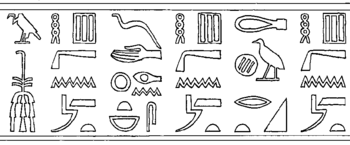Nimaathapi
| Nimaathapi in hieroglyphics | ||||||
|---|---|---|---|---|---|---|
| Surname |
Nimaathapi (Ni maat Hapi) Nj m3ˁ.t Ḥp Belonging to Apis is the Maat |
|||||
| title |
Mut-nesut Mw.t-nswt mother of the king |
|||||
| 2nd title |
Mut-mesu-nesut Mw.t-msw-nswt mother of the royal children |
|||||
| 3rd title |
Djed-chet-neb-iret-nes Ḏd (.t) -ẖt-nb (.t) -jr (.t = tw) -n = s Who says something that will be done for them |
|||||
| Seal imprint (detail) with the name and title of Nimaathapi; Site: Beit Khallaf | ||||||
Nimaathapi (also Ni-maat-Hapi or Nimaat-Hap ) was an ancient Egyptian queen towards the end of the 2nd Dynasty . She was the wife of King ( Pharaoh ) Chasechemui and the mother of King Djoser . Their titles may reinforce the belief that Djoser was the direct successor of Chasechemui.
Name and identity

The name "Ni-maat-Hapi" is based on the god Apis .
Nimaathapi is believed to be the mother of King Djoser , the first ruler of the 3rd Dynasty . This is evidenced by stone vessels and clay seals on which the title Mw.t-nswt (" Mother of the King ") appears. On one of the seals even the title Mw.t-msw-nswt ("Mother of the King's Children") appears, which illustrates Nimaathapi's special position as the mother of two heirs to the throne and as the king's wife. Their position of power is emphasized by the title Ḏd (.t) -ẖt-nb (.t) -jr (.t = tw) -n = s (“ Who says something that (one) will do for you (immediately) "). Only three other queens of the Old Kingdom carried this title of power: Hetepheres I , Inetkaes II and Meritites I.
supporting documents
Nimaathapi's name appears on clay seals from Abydos in the tomb of Chasechemui and in the mastabas K1 and K2 in Beit Khallaf .
A relief fragment comes from Heliopolis , on which she is shown together with her daughter Inetkaes and the king consort Hetephernebti at the feet of King Djoser. The occasion was the celebration of the Sed -Fest. The portrayal of Nimaathapi may indicate that she was still alive at the time. This assumption is supported by their seals from the grave of their husband, which in turn indicates that Djoser and Nimaathapi organized the burial of Chasechemui together. Nimaathapi does not appear in the grave district of Djoser in Saqqara , her name has been replaced by the representation of the cemetery god Anubis .
In the funerary inscription of the high official Metjen (end of the 3rd dynasty or beginning of the 4th dynasty ) there is a mention of a ḫw.t k3 nj (.t) mw.t nswt ("Ka house of the king's mother"), what a long cult of the dead around Nimaathapi and again underlines their special position during their lifetime.
literature
- Michel Baud : Famille royale et pouvoir sous l'Ancien Empire égyptien. Tome 2 (= Bibliothèque d'Étude. Volume 126/2). Institut Français d'Archéologie Orientale, Cairo 1999, ISBN 2-7247-0250-6 , pp. 477–478 ( PDF; 16.7 MB ).
- Silke Roth: The royal mothers of ancient Egypt from the early days to the end of the 12th dynasty. Harrassowitz, Wiesbaden 2001, ISBN 3-447-04368-7 , (= Egypt and Old Testament Vol. 46), (At the same time: Mainz, Univ., Diss., 1997), pp. 59-67.
- Hermann A. Schlögl : Ancient Egypt: History and culture from the early days to Cleopatra. Beck, Frankfurt 2006, ISBN 3406549888 , p. 78.
- Joyce Tyldesley : Chronicle of the queens of Egypt: from early dynastic times to the death of Cleopatra. Thames & Hudson, London 2006, ISBN 0500051453 , pp. 25 & 35 - 39.
- Toby AH Wilkinson : Early Dynastic Egypt. Routledge, London 2001, ISBN 0415260116 , pp. 94-97.
Individual evidence
- ↑ Silke Roth: The royal mothers of ancient Egypt. P. 384.
- ↑ Silke Roth: The royal mothers of ancient Egypt. Fig. 21
- ↑ Silke Roth: The royal mothers of ancient Egypt . Fig. 20
| personal data | |
|---|---|
| SURNAME | Nimaathapi |
| ALTERNATIVE NAMES | Ni-maat-Hapi; Nimaat-Hap |
| BRIEF DESCRIPTION | Mother of King Djoser |
| DATE OF BIRTH | 28th century BC Chr. |
| DATE OF DEATH | 28th century BC Chr. |
